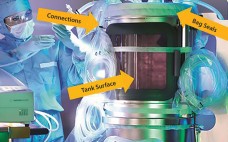Single-use technology is well accepted today, and manufacturers’ quality assurance programs ensure leak-free single-use bags upon delivery. But what about risks involved with installation and other handling errors? Operator training and implementation of suitable standard operating procedures (SOPs) are mandatory, but should they be the only ways to mitigate the risk of failures? In addition, more companies are advocating the use of ballroom concepts (1) for the manufacture of biopharmaceutical drug substances and drug products. However, how do you prove…
Upstream Validation
Ready-to-Use Cryopreserved Primary Cells
Abiological measurement of drug activity is perhaps the most critical step in the series of tests required for product release both for clinical trials and the market. This evaluation plays an important role in the stability assessment of drug candidates. According to the International Conference on Harmonisation of Technical Requirements for Registration of Pharmaceuticals for Human Use (ICH) Q6B document, measurements of biological activity can be performed in defined animal models that demonstrate a measurable physiological change in response to…
How to Hit a Moving Target
Although multiple factors can compromise the drug-like properties of biological molecules, we are still at a very early stage in learning how to assess them. This is despite — or perhaps more correctly, because of — the pharmaceutical industry’s accelerating drive to develop biological molecules as therapeutic agents. And I say “we” because this applies not only to the biopharmaceutical industry itself and the analytical instrument companies that serve it, but also those charged with regulating it. We are all…
Process Improvements Increase Production Capacity of a Legacy Product
Implementation of postlicensure process improvements in the biopharmaceutical industry can benefit patients and drug manufacturers alike. Here we demonstrate through a case study how a change to the cell culture medium and process can be taken from proof of concept through scale-up to demonstration of feasibility. We further illustrate the scope and complexity of implementing a change in commercial manufacturing to realize significant benefits such as increased production capacity over an existing legacy process. The Importance of Postapproval Improvements Drug…
New Paradigms for Process Validation
Both the United States and the European Union have recently evolved guidance on how to execute process validation (1, 2) with the prospect of a more appropriate life-cycle approach. It goes beyond the traditional three to five lots run at the center point of proposed ranges for operating parameters. New approaches leverage product design and process development information. They facilitate adapting the quality by design (QbD) paradigm to allow for a science- and risk-based selection of critical process…
Implementation of Quality By Design in Vaccine Development
At the IBC Third Annual International Forum on Vaccine Production, I presented an outline of “Best Practices for Quality by Design (QbD) in Biological Products and How to Implement in Vaccines.” It covered process development and QbD principles, best practices used in biologics, how QbD fits in with process validation, how it applies to vaccines, and some thoughts on the potential for seasonal vaccines. Shifts in Process Development Classic process development (as practiced in the early days) generally involved rudimentary…
A Host Cell Protein Assay for Biologics Expressed in Plants
Host cell proteins (HCPs) can be present in significant amounts in biological products through copurification with a recombinant protein-drug substance. Purified active ingredients developed for human use must be free of all contaminants — including residual HCPs — to minimize the incidence of immunogenicity against a drug product or its trace contaminants (1). HCP assays allow for monitoring host-related impurities during product development and process development. Most are in the enzyme-linked immunosorbent assay (ELISA) format for detecting…
How QbD and the FDA Process Validation Guidance Affect Product Development and Operations, Part 1
Earlier this year, the FDA issued its long-awaited process validation guidance document, which had been several years in development. It is well written and effectively articulates what many progressive companies have been thinking and doing for years. But many people in the industry are asking questions: How will it affect our process development programs? How will it affect the submissions and licensure of our products? And how will it aid in our commercial operations? Or will it have…
Implementation of the ASTM Standard for Manufacturing Systems Verification
In 2007, ASTM International (ASTM), formerly known as the American Society for Testing and Materials, published its “E2500-07” international industry consensus standard for conducting a risk-based design and qualification of good manufacturing practice (GMP) manufacturing systems (1). This guide incorporates risk- and science-based practices to focus on critical aspects affecting equipment systems throughout their design–qualification–operation lifecycle. Presentations at recent PDA and ISPE annual meetings indicate that the bioprocess industry is embracing E2500 to improve system designs and reduce costly validations.…
Top 10 Changes in FDA’s Process Validation Guidance
Two years after drafting a comprehensive revision of the 1987 process validation guidance, the FDA finalized the document this year. The revision elaborates on modern quality by design (QbD) techniques for developing a process, analyzing risks, and monitoring for control. The initial draft update remains largely intact, with some important adjustments focused on clarifying the FDA’s intent for how the industry is expected to validate its processes. 1 — Minor Changes: The guidance includes more references to the Code of…

